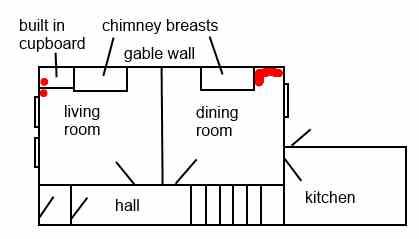- Joined
- 8 Jul 2011
- Messages
- 56
- Reaction score
- 0
- Country

Hi,
I hope this is the correct forum to be asking this.
I live in an end terrace and on the corners of each room at the gable wall, the paint is peeling and bubbling off. There is also some wet looking staining on the wall, which are quite low down up to about waist height. I have marked these spots in red in the diagram. This is also happening on the first floor in the front room above the living room right into the corner. In a couple of the rooms, you can see in the top corner, what looks like where water has run off the cornicing.
I think that this is caused by condensation on the colder outside walls, but I am by no means an expert. I make a point of not drying clothes on the radiators in these rooms, but the dining room gets some steam from the kitchen while cooking. We also had a damp proof course installed about 2 years ago.
Would this be likely due to condensation, or does it seem likely that the DPC has failed (obviously this isn't the case on the first floor)? Any advice would be greatly appreciated.
I hope this is the correct forum to be asking this.
I live in an end terrace and on the corners of each room at the gable wall, the paint is peeling and bubbling off. There is also some wet looking staining on the wall, which are quite low down up to about waist height. I have marked these spots in red in the diagram. This is also happening on the first floor in the front room above the living room right into the corner. In a couple of the rooms, you can see in the top corner, what looks like where water has run off the cornicing.
I think that this is caused by condensation on the colder outside walls, but I am by no means an expert. I make a point of not drying clothes on the radiators in these rooms, but the dining room gets some steam from the kitchen while cooking. We also had a damp proof course installed about 2 years ago.
Would this be likely due to condensation, or does it seem likely that the DPC has failed (obviously this isn't the case on the first floor)? Any advice would be greatly appreciated.


